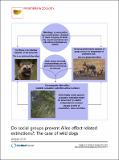Por favor, use este identificador para citar o enlazar a este item:
http://hdl.handle.net/10261/74361COMPARTIR / EXPORTAR:
 SHARE
BASE SHARE
BASE
|
|
| Visualizar otros formatos: MARC | Dublin Core | RDF | ORE | MODS | METS | DIDL | DATACITE | |

| Campo DC | Valor | Lengua/Idioma |
|---|---|---|
| dc.contributor.author | Angulo, Elena | - |
| dc.contributor.author | Rasmussen, Greg S. A. | - |
| dc.contributor.author | Macdonald, D.W. | - |
| dc.contributor.author | Courchamp, Franck | - |
| dc.date.accessioned | 2013-04-15T15:06:23Z | - |
| dc.date.available | 2013-04-15T15:06:23Z | - |
| dc.date.issued | 2013-03-15 | - |
| dc.identifier | http://dx.doi.org/10.1186/1742-9994-10-11 | - |
| dc.identifier.citation | Frontiers in Zoology. 10(1):11 (2013) | - |
| dc.identifier.uri | http://hdl.handle.net/10261/74361 | - |
| dc.description.abstract | Abstract Background Allee effects may arise as the number of individuals decreases, thereby reducing opportunities for cooperation and constraining individual fitness, which can lead to population decrease and extinction. Obligate cooperative breeders rely on a minimum group size to subsist and are thus expected to be particularly susceptible to Allee effects. Although Allee effects in some components of the fitness of cooperative breeders have been detected, empirical confirmation of population extinction due to Allee effects is lacking yet. Because previous studies of cooperation have focused on Allee effects affecting individual fitness (component Allee effect) and population dynamics (demographic Allee effect), we argue that a new conceptual level of Allee effect, the group Allee effect, is needed to understand the special case of cooperative breeders. Results We hypothesize that whilst individuals are vulnerable to Allee effects, the group could act as a buffer against population extinction if: (i) individual fitness and group fate depend on group size but not on population size and (ii) group size is independent of population size (that is, at any population size, populations comprise both large and small groups). We found that both conditions apply for the African wild dog, Lycaon pictus, and data on this species in Zimbabwe support our hypothesis. Conclusions The importance of groups in obligate cooperative breeders needs to be accounted for within the Allee effect framework, through a group Allee effect, because the group mediates the relationship between individual fitness and population performance. Whilst sociality is associated with a high probability of Allee effects, we suggest that cooperative individuals organized in relatively autonomous groups within populations might be behaving in ways that diminish extinction risks caused by Allee effects. This study opens new avenues to a better understanding of the role of the evolution of group-living on the probability of extinction faced by social species. | - |
| dc.description.sponsorship | acknowledges support from the Spanish Ministry of Education and Culture (SEEU-FSE), F.C. from the ANR, and D.W.M. from the PTES. We acknowledge support of the publication fee by the CSIC Open Access Publication Support Initiative through its Unit of Information Resources for Research (URICI). | - |
| dc.language.iso | eng | - |
| dc.publisher | BioMed Central | - |
| dc.relation.isversionof | Publisher's version | - |
| dc.rights | openAccess | - |
| dc.title | Do social groups prevent Allee effect related extinctions?: The case of wild dogs | - |
| dc.type | artículo | - |
| dc.date.updated | 2013-04-15T15:06:23Z | - |
| dc.description.version | Peer Reviewed | - |
| dc.rights.holder | Elena Angulo et al.; licensee BioMed Central Ltd. | - |
| dc.type.coar | http://purl.org/coar/resource_type/c_6501 | es_ES |
| item.openairetype | artículo | - |
| item.grantfulltext | open | - |
| item.cerifentitytype | Publications | - |
| item.openairecristype | http://purl.org/coar/resource_type/c_18cf | - |
| item.fulltext | With Fulltext | - |
| item.languageiso639-1 | en | - |
| Aparece en las colecciones: | (EBD) Artículos | |
Ficheros en este ítem:
| Fichero | Descripción | Tamaño | Formato | |
|---|---|---|---|---|
| 1742-9994-10-11.xml | 128,42 kB | XML | Visualizar/Abrir | |
| 1742-9994-10-11-S1.PDF | 104,75 kB | Adobe PDF |  Visualizar/Abrir | |
| 1742-9994-10-11.pdf | 994,39 kB | Adobe PDF |  Visualizar/Abrir |
CORE Recommender
Page view(s)
286
checked on 18-abr-2024
Download(s)
421
checked on 18-abr-2024
Google ScholarTM
Check
NOTA: Los ítems de Digital.CSIC están protegidos por copyright, con todos los derechos reservados, a menos que se indique lo contrario.
